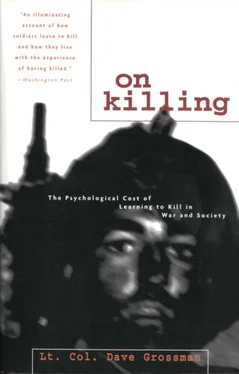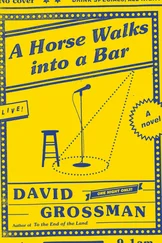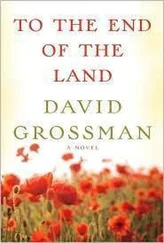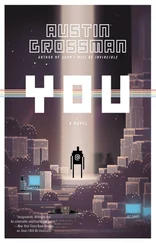It is my contention that most of these discarded weapons on the battlefield at Gettysburg represent soldiers who had been unable or unwilling to fire their weapons in the midst of combat and then had been killed, wounded, or routed. In addition to these twelve thousand, a similar proportion of soldiers must have marched off that battlefield with similarly multiloaded weapons.
Secretly, quietly, at the moment of decision, just like the 80 to 85 percent of World War II soldiers observed by Marshall, these soldiers found themselves to be conscientious objectors who were unable to kill their fellow man. This is the root reason for the incredible ineffectiveness of musket fire during this era. This is what happened at Gettysburg, and if you look deeply enough you will soon discover that this is also what happened in the other black-powder battles about which we do not necessarily have the same kind of data.
A case in point is the Battle of Cold Harbor.
“Eight Minutes at Cold Harbor”
The Battle of Cold Harbor deserves careful observation here, since it is the example that most casual observers of the American Civil War would hold up to refute an 80 to 85 percent nonfiring rate.
In the early morning hours of the third of June 1864, forty thousand Union soldiers under the command of Ulysses S. Grant attacked the Confederate army at Cold Harbor, Virginia. The Confederate forces under Robert E. Lee were in a carefully prepared system of trenches and artillery emplacements unlike anything that Grant’s Army of the Potomac had ever encountered. A newspaper correspondent observed that these positions were “intricate, zig-zagged lines within lines… lines built to enfilade an opposing line, lines within which lies a battery [of artillery].” By the evening of the third of June more than seven thousand attacking Union soldiers were killed, wounded, or captured while inflicting negligible damage on the well-entrenched Confederates.
Bruce Catton, in his superb and definitive multivolume account of the Civil War, states, “Offhand, it would seem both difficult and unnecessary to exaggerate the horrors of Cold Harbor, but for some reason — chiefly, perhaps, the desire to paint Grant as a callous and uninspired butcher — no other Civil War battle gets as warped a presentation as this one.”
Catton is referring largely to exaggerated accounts of Union casualties (usually claiming the thirteen thousand casualties of two weeks’ fighting at Cold Harbor as the casualty rate for the one day’s fighting), but he also debunks the very common misconception that seven thousand (or even thirteen thousand) casualties occurred in “Eight Minutes at Cold Harbor.” This belief is not so much wrong as it is a gross oversimplification. It is quite correct that most of the isolated, disjointed Union charges launched at Cold Harbor were halted in the first ten to twenty minutes, but once the attackers’ momentum was broken the attacking Union soldiers did not flee, and the killing did not end. Catton notes that “the most amazing thing of all in this fantastic battle is the fact that all along the front the beaten [Union soldiers] did not pull back to the rear.” Instead they did exactly what Union and Confederate soldiers had done over and over again in that war: “They stayed where they were, anywhere from 40 to 200 yards from the confederate line, gouging out such shallow trenches as they could, and kept on firing.” And the Confederates kept on firing at them, often with cannons firing from the flanks and rear at horrendously short range. “All day long,” says Catton, “the terrible sound of battle continued. Only an experienced soldier could tell by the sound alone, that the pitch of the combat in midafternoon was any lower than it had been in the murky dawn when the charges were being repulsed.”
It took over eight hours, not eight minutes, to inflict those horrendous casualties on Grant’s soldiers. And as in most wars from the tine of Napoleon on down to today, it was not the infantry but the artillery that inflicted most of these casualties.
Only when artillery (with its close supervision and mutual surveillance processes among the crew) is brought into play can any significant change in this killing rate be observed. (The greater distance that artillery usually is from its targets, as we will see, also increases its effectiveness.) The simple fact appears to be that, like S. L. A. Marshall’s riflemen of World War II, the vast majority of he rifle- and musket-armed soldiers of previous wars were consistent and persistent in their psychological inability to kill their fellow human beings. Their weapons were technologically capable, and they were physically quite able to kill, but at the decisive moment each man became, in his heart, a conscientious objector who could not bring himself to kill the man standing before him.
This all indicates that there is a force in play here. A previously undiscovered psychological force. A force stronger than drill, stronger than peer pressure, even stronger than the self-preservation instinct. The impact of this force is not limited to only the black-powder era or only to World War II: it can also be seen in World War I.
Colonel Milton Mater served as an infantry company commander in World War II and relates several World War II experiences that strongly support Marshall’s observations. Mater also provides us with several instances in which World War I veterans warned him to expect that there would be many nonfirers in combat.
When he first joined the service in 1933, Mater asked his uncle, a veteran of World War I, about his combat experience. “I was amazed to find that the experience foremost in his mind was ‘draftees who wouldn’t shoot.’ He expressed it something like this: ‘They thought if they didn’t shoot at the Germans, the Germans wouldn’t shoot at them.’”
Another veteran of the trenches of World War I taught Mater in an ROTC class in 1937 that, based on his experiences, nonfirers would be a problem in any future war. “He took pains to impress us with the difficulty of making some men fire their rifles to avoid becoming sitting ducks for the fire and movement of the enemy.”
There is ample indication of the existence of the resistance to killing and that it appears to have existed at least since the black-powder era. This lack of enthusiasm for killing the enemy causes many soldiers to posture, submit, or flee, rather than fight; it represents a powerful psychological force on the battlefield; and it is a force that is discernible throughout the history of man. The application and understanding of this force can lend new insight to military history, the nature of war, and the nature of man.
CHAPTER THREE
Why Can’t Johnny Kill?
Why did individual soldiers over hundreds of years refuse to kill the enemy, even when they knew that doing so would endanger their own lives? And why, if this has been so throughout history, have we not been fully aware of it?
Many veteran hunters, upon hearing accounts of nonfirers, might say, “Aha, buck fever,” and they would be quite right. But what is buck fever? And why do men experience during the hunt that inability to kill that we call buck fever? (The relationship between the failures to kill on the battlefield and failures to kill in the hunt are explored more completely in a later section.) We must turn back to S. L. A. Marshall for the answer.
Marshall studied this issue during the entire period of World War II. He, more than any other individual prior to him, understood the thousands of soldiers who did not fire at the enemy, and he concluded that “the average and healthy individual… has such an inner and usually unrealized resistance towards killing a fellow man that he will not of his own volition take life if it is possible to turn away from that responsibility…. At the vital point,” says Marshall, the soldier “becomes a conscientious objector.”
Читать дальше







